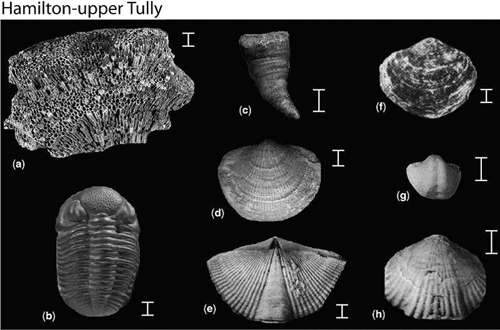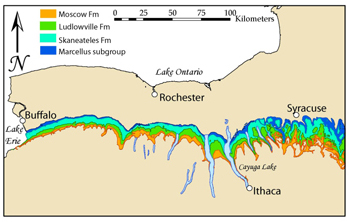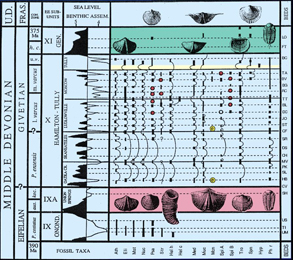Coordinated Stasis and Devonian Evolutionary Ecology of New York State
Long-term ecological and evolutionary stability is implied by our ability to recognize group-level differences in faunal composition in the stratigraphic record. The pattern of coordinated stasis is defined as long intervals of concurrent taxonomic and ecologic persistence separated by comparatively abrupt periods of biotic change, and was first described by Carl Brett and Gordon Baird based on marine faunas of the Silurian and Devonian of the Appalachian Basin. The fauna of the Middle Devonian Hamilton Group has been the type example, but discussion persists on just how stable the fauna is, and how best to assess it. Quantitative statistical analyses show that taxonomic and ecologic composition is more variable within stratigraphic horizons than between them, suggesting minimal net change through time in the assemblage. Observed stratigraphic distributions of fossils are consistent with a scenario in which all taxa are present from bottom to top of the unit, and absences result only from sampling failure. Extinction rate within the Hamilton Group is far lower than background levels for the Devonian. These results are consistent with the pattern of coordinated stasis. See Ivany et al. (2009), Brett et al. (2009).



Collaborators
- Carlton Brett (Cincinnati)
- John Handley (Xerox)
Student Research
- Patrick Wall (Ph.D.) “Incorporating spatial datasets into paleontology: Effects on estimates of diversity, origination, and extinction.”
Publications
(*student author; †postdoc author)
Wall*, Patrick D., Ivany, Linda C., and Brett, Carlton E. (in revision) The influence of geographic sampling scale on apparent taxonomic turnover rates: A case study in the Hamilton Group (Middle Devonian) of New York. Paleobiology.
Ivany, Linda C., Brett, Carlton E., Wall*, Heather L.B., Wall*, Patrick D., Handley, John C. (2009) Relative taxonomic and ecologic stability in Devonian marine faunas of New York State: A test of coordinated stasis. Paleobiology, v. 35, p. 499-524.
Brett, C.E., L.C. Ivany, A.J. Bartholomew, M.K. DeSantis, and G.C. Baird. (2009) Devonian ecological-evolutionary subunits in the Appalachian Basin: A revision and a test of persistence and discreteness. In Koenigshof , P. (ed.) Devonian Change: Case Studies in Palaeogeography and Palaeoecology. Journal of the Geological Society of London, Special Publication 314, p. 7-34.
Bonuso, Nicole B., Newton, Cathryn R., Brower, James C., and Ivany, Linda C. (2002) Does coordinated stasis yield taxonomic and ecologic stability? Middle Devonian Hamilton Group of Central New York State. Geology 30, pp. 1055-1058.
Bonuso, Nicole B., Newton, Cathryn R., Brower, James C., and Ivany, Linda C. (2002) Statistical testing of community patterns: Uppermost Hamilton Group, Middle Devonian (New York State, U.S.A.). Palaeogeography, Palaeoclimatology, Palaeoecology, 185, pp.1-24.
Schopf, Kenneth M. & Ivany, Linda C. (1998) Scaling the ecosystem: a hierarchical view of stasis and change, in McKinney, Michael L. and Drake, James A. (eds) Biodiversity Dynamics: Turnover of Populations, Taxa, and Communities. Columbia University Press, New York, pp. 187-211.
Ivany, Linda C. (1996) Coordinated stasis or coordinated turnover? Exploring intrinsic versus extrinsic controls on pattern. Palaeogeography, Palaeoclimatology, Palaeoecology, Volume 127(1-4), pp. 239-256.
Brett, Carlton E., Ivany, Linda C., & Schopf, Kenneth M. (1996) Coordinated stasis in marine communities: an overview. Palaeogeography, Palaeoclimatology, Palaeoecology, Volume 127(1-4), pp. 1-20.
Ivany, Linda C. & Schopf, Kenneth M. (Editors) (1996) “New perspectives on faunal stability in the fossil record”, a theme issue of Palaeogeography, Palaeoclimatology, Palaeoecology, Volume 127, no. 1-4.
Morris, Paul J., Ivany, Linda C., Schopf, Kenneth M., & Brett, Carlton E. (1995) The challenge of paleoecological stasis: Reassessing sources of evolutionary stability. Proceedings of the National Academy of Sciences USA, Volume 92, no. 24, pp. 11269-11273.
